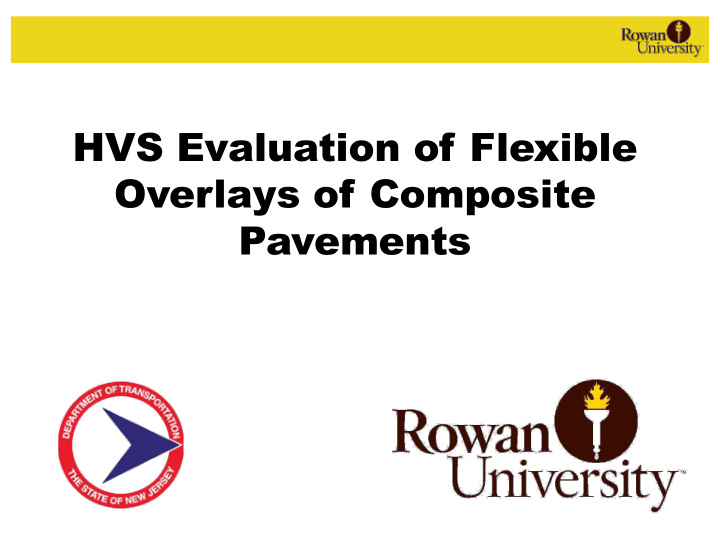



HVS Evaluation of Flexible Overlays of Composite Pavements
Background q Approximately 50% of the pavements in New Jersey (NJ) are in “Poor” condition. q Approximately 50% of those pavement are composite pavements ( asphalt layer on top of a Portland Cement Concrete (PCC) layer ).
Background q To improve the conditions of NJ pavements, there is a need to investigate the potential for using thin asphalt overlays. q Overlays are used for rehabilitating and preserving PCC pavements.
Study Objective q Identify and predict the expected life of thin asphalt overlay treatments
Full Scale Pavement Sections Plan View of the Full-Scale Pavement Sections Planned for this Project: 9.5 ME HMA (3 in.)
Full Scale Pavement Sections Cross-Section Thin Asphalt Overlay View of the Full- Scale Pavement Sections Planned Portland Cement Concrete for this Project à 3 ft. Comp. Unbound Base Thin asphalt layer Compacted Subgrade ≈ 3 in. PCC layer Existing Soil ≈ 8 in.
Portland Cement Concrete Layer q Cylinders were prepared with the mix q 7 – day compressive strength test was conducted and passed q 14 – day and 28 – day tests will be performed
Portland Cement Concrete Layer q Poured on Oct 4 th , 5 th , and 7 th
Thin Asphalt Overlays q Six full-scale pavement sections will be constructed in the RU-APTF q Four thin asphalt overlay mixes; Ø Traditional Superpave Mix Ø Stone Matrix Asphalt (SMA) Mix Ø High Performance Thin Overlay Ø Binder Rich Intermediate Course (BRIC)
Testing Sections
Testing Sections
Testing Sections
Laboratory Experiments q Mixture Tests § Volumetrics o Total Air Voids (VTM) o Aggregate Gradation WAQTC TM 13 (12) § Binder Content o Binder Content (Extraction & Recovery of Binder) § Performance Tests o Overlay Tester (OT) o Asphalt Pavement Analyzer (APA) o Tensile Strength Ratio (TSR) 5
Instrumentation q Procurement Status Sensor/DAQ Status NI cDAQ System Delivered Pressure Cells Installed Soil Compression Gauges Installed Thermocouple Installed * Asphalt Strain Gauges Delivered LVDTs Installed * Installed in I-3 Only 11
Instrumentation q Installation of Sensors q Army Corps of Engineers (USACE) assisted Rowan team with the preparation and installation of the sensors q Rowan team installed pressure cells and thermocouples with help of USACE in I-3 subbase layer q Rowan team installed compression gauges with help of USACE in second layer of I-3 13
• Instrumentation 5 ft. 5 ft. 5 ft. 5 ft. 5 ft. 5 ft. Sensor Layout Longitudinal Asphalt Strain HMA 3” Gauges (Total: 2) Pressure Cell (Total: 2, 2 PCC 11” 600KPa and 1 250KPa) Macrosensors LVDT I-3 (Layer -2) (Total: 2) 26” I-3 (Layer -1) CTL Soil Compression Gauge (Total: 2) HMA Temperature Sensors (Total: 31” Compacted Soil 3 T-type Thermocouples) Type T thermocouples will be used for temperature Soil Bed measurements . 5 ft. 5 ft. 5 ft. 5 ft. 5 ft. 5 ft.
Pressure Sensor Installation
Thermocouple Installation
• Compression Gauge Installation
Recommend
More recommend